Lenovo Yoga 3 Pro Review: Refreshed With Faster Core M
by Brett Howse on March 13, 2015 8:00 AM ESTDisplay
The Yoga 3 Pro keeps the same display resolution as the Yoga 2 Pro, but the model number has been bumped from the SDC424A to SDC434A. The good is that this is already a high resolution display, with 3200x1800 pixels. The bad is that the Samsung made display is a Red Green Blue White (RGBW) subpixel arrangement, which can cause issues with color reproduction and contrast. Luckily Lenovo has sorted out the color reproduction for the Yoga 3 Pro, just like they did with the Yoga 2 Pro a few months into its life.
The higher display density can cause issues with some Windows apps, but overall it is less of a problem now. Hopefully Windows 10 will fix the last remaining issues with high DPI displays.
The Samsung display now has some competition as well. As we have recently seen, Dell launched the new XPS 13 with a Sharp IGZO 3200x1800 display. The Lenovo does come in a bit less expensive, but the Sharp displays have proven to be very good for brightness, black levels, contrast, and color reproduction.
To test our displays, we use SpectralCal’s CalMAN 5 software suite, with an X-Rite i1Display Pro colorimeter for brightness and contrast testing, and the X-Rite i1Pro spectrophotometer for color accuracy.
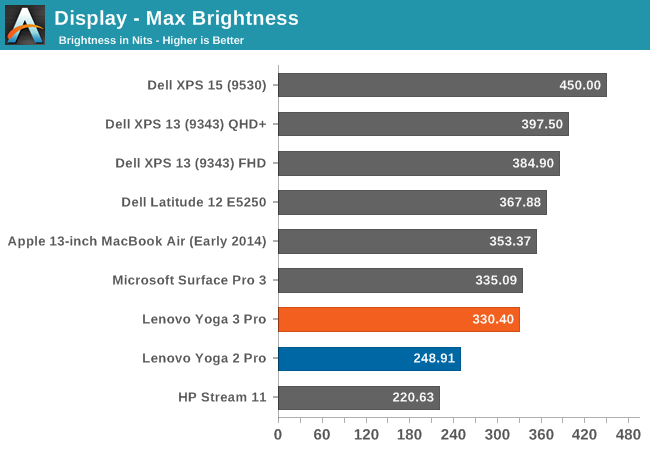

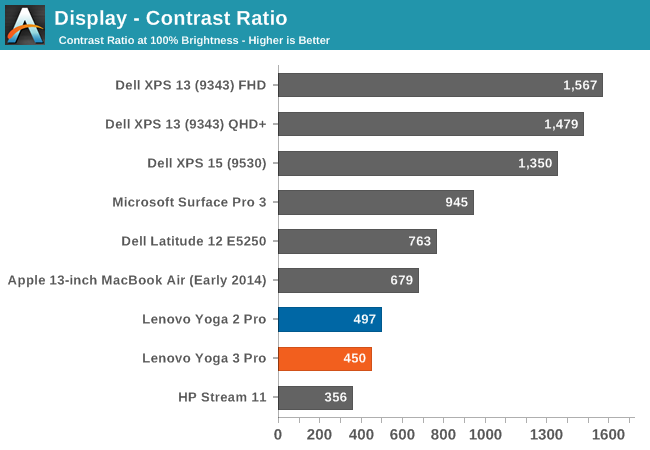
The Yoga 2 Pro was only able to hit 248 nits, and the Yoga 3 Pro can achieve 330 nits, which is a good improvement. However the black levels are very high, with 0.73 nits at maximum brightness, which leads to a mediocre 450:1 contrast ratio. The Dell XPS 13 was able to get over 1500:1, with a higher brightness as well. Lenovo needs to move away from the Samsung display if they can.
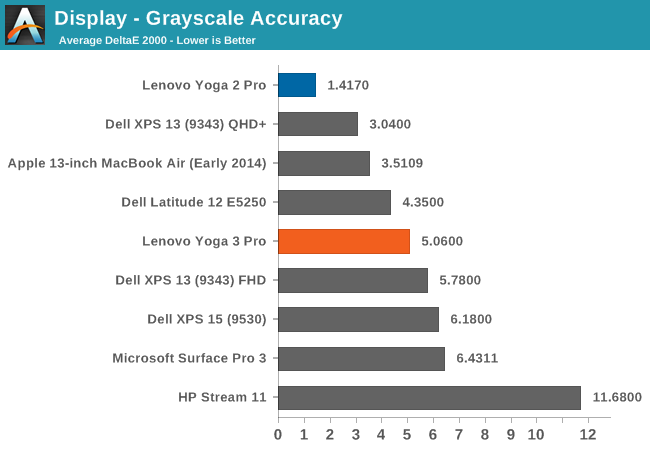
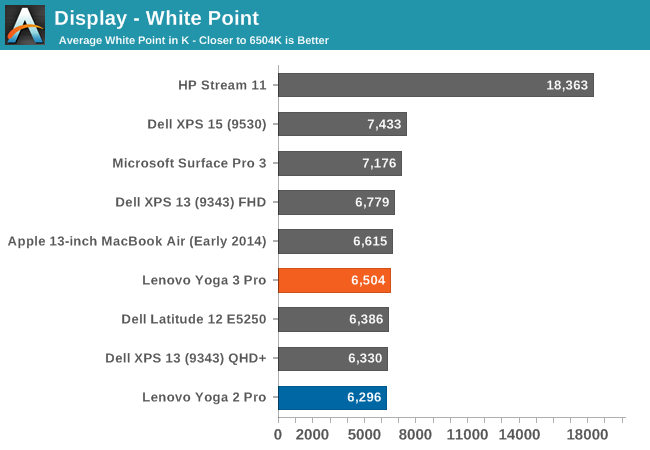
In the Grayscale sweep, you can see that the blue colors drop off quite substantially in the upper levels. This gives us an average dE of just over 5. It is not horrible, but not as good as we have seen from competing devices lately. Luckily this can be corrected through calibration. The White Point is ideal though, and the default gamma comes in close to the 2.2 that we are looking for.
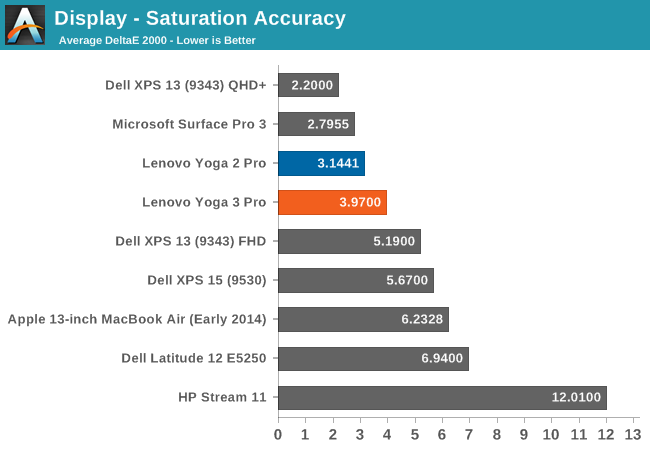
The saturations on the Yoga 3 Pro are pretty good, with the display able to cover the sRGB gamut with the exception of the Blue range which cannot quite hit the 100% level. Still, it is a reasonable showing.
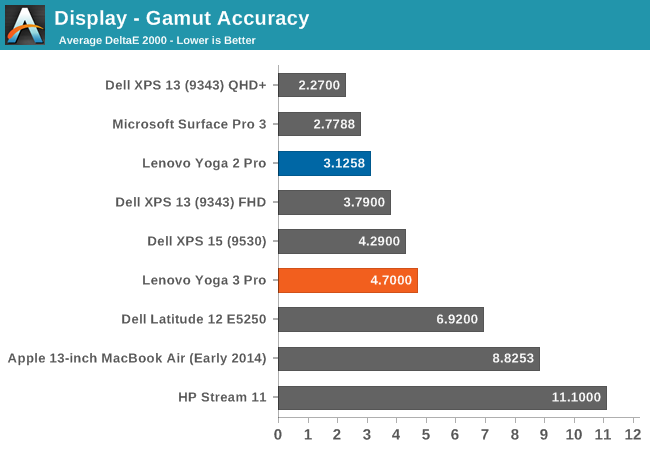

The GMB score is also reasonable, with the Yoga 3 Pro coming in just under 4. It is not the best nor worst display we have seen, but the bar has been raised and it would be good to see more devices having better quality displays. It seems like a broken record, since we have now pretty much moved away from TN panels on all premium devices, but we still have a ways to go.
The Yoga 3 Pro had no issues being calibrated, and we were able to run through our tests and clean up the scores a bit. Calibration on a device like this mostly just fixes the grayscale, but it can be a big improvement.
The grayscale result is much better once calibrated, coming in at just 1.34. All of the other scores have improved as well, with saturation now 2.337, GMB at 2.5013, and gamut at 3.6681. Once calibrated, the display behaves very well, although the contrast ratio cannot be corrected through calibration. That is really the one detriment to this display. The RGBW layout is not ideal and hopefully Lenovo will move to a different display for future models. The Samsung display just has very poor blacks, and it can be distracting when using the device for watching dark movies. Still, it would be a nice benefit if Lenovo would include an ICC profile for the display to correct what can be corrected.



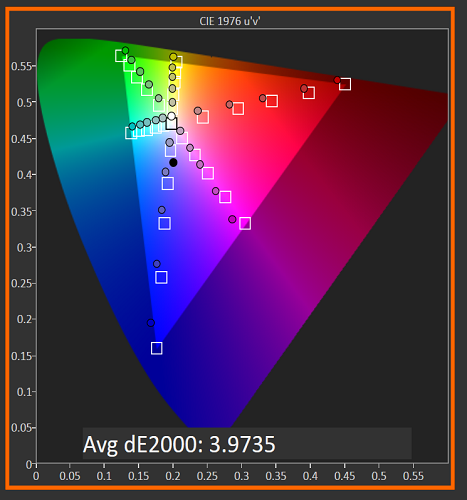

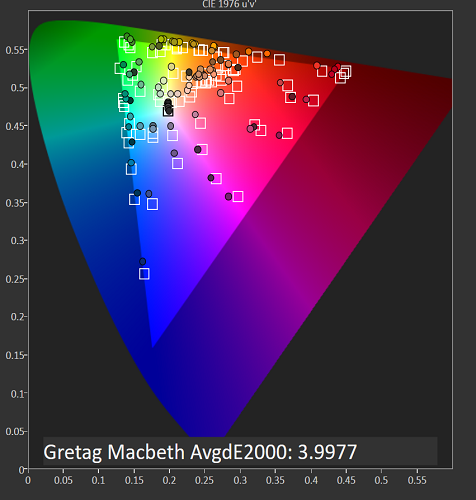












113 Comments
View All Comments
edzieba - Friday, March 13, 2015 - link
I'd be a lot more accepting of RGBW (and RGBG) subpixel-arrangement displays if they didn't do the shady thing of counting only two subpixels as one pixel (meaning a single addressable pixel cannot reproduce the whole display gamut).fokka - Friday, March 13, 2015 - link
i agree, but how else would you "count" subpixels on a RGBG matrix? and as far as i can see, the RGBW even uses 4 subpixels per pixel, or did i miss something? of course the whole pixel gets quite long this way, which isn't ideal for sharpness, but on a 1800p display i don't even care anymore.zepi - Friday, March 13, 2015 - link
So this thing has 4 subpixels for each pixel, but the display controller only takes R,G,B as input from computer for each pixel?Well, I guess it is an acceptable way of increasing brightness for high-dpi displays to keep the power consumption low.
peterfares - Friday, March 13, 2015 - link
No, it has TWO subpixels per pixel. RGBW theoretically sounds nice if it was 4 subpixels per pixel, but with just two then it ruins everything. Color reproduction, sharpness, black levels, etc. A 1080p RGB looks pretty much as good.fokka - Friday, March 13, 2015 - link
ok, now i'm completely confused. there i thought it used 4 subpixels, where do you get it used only two?my dissent for pentile only grows, it could be so easy with 1080/1200p, 1440/1600p RGB, but no, someone always has to cheat in this stupid dick measuring contest.
lolTyler - Friday, March 13, 2015 - link
"Luckily Lenovo has sorted out the color reproduction for the Yoga 3 Pro, just like they did with the Yoga 2 Pro a few months into its life."No, they did not fix this on the Yoga 2 Pro. I have all the BIOs updates and all the power management updates. Lenovo's idea of "fixing" this issue is turning your machine to the most power hungry mode and cranking your brightness to 100%, thus giving your machine ~1 or 2 hours of battery life. That's the only way to get correct yellows, otherwise, you get mustardy variations.
Lenovo will not recognize that the problem still exists and just closes threads or sweeps customer complaints under the rug. I do not know what this is like on the Y3P, but it's still fudged on the 2.
Brett Howse - Friday, March 13, 2015 - link
The one that we tested was produced after they "fixed" it, and our i1Pro shows that they did indeed fix this issue. http://images.anandtech.com/doci/8289/Saturation.p...I can't comment on the ones produced before the fix though. They could still have an issue but I don't have one to even look at.
Regular Reader - Friday, March 13, 2015 - link
I'm going to pick some random nits: why the hell do PC makers still slap those stickers on their machines? OK ok, I know AMD is still around, so maybe Intel wants to make sure people know what's "inside", but why the "Intel Ultrabook" sticker? Why Windows or Office badges? This garbage just muddies up these machines, and they don't always come off nicely. It's such a waste of time and material. What average person on the street doesn't know a non-Apple laptop comes with Windows? Some may argue that there are now cheapo Chromebooks out there, but Windows and Chrome clearly do not look the same.That is all. Please return to your regularly scheduled comments.
fokka - Friday, March 13, 2015 - link
i can only agree here and add: if you want your machine look cheap, put a bunch of stickers on it.peterfares - Friday, March 13, 2015 - link
PenTile screen means the screen is still garbage. I'd rather a 1080p RGB than this abomination.